Monsters
The most important aspect of the game is the collection of monsters. Train, synthesize, and enhance your monsters to make them stronger. Stronger monsters can take on stronger challenges.
Remember, monsters aren’t just for fighting. They are also your friends!
Monster Info
You can view the following details under Monster Info:
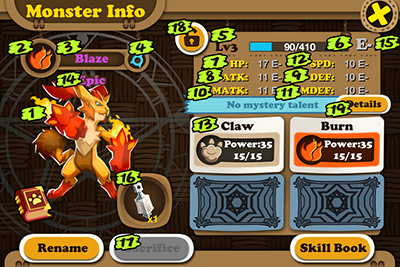
| 1. Portrait: | Your monster facing front. |
| 2. Type: | Element type. |
| 3. Name: | Monster name. |
| 4. Gender: | Monster gender. |
| 5. Level: | Monster level. |
| 6. EXP: | Experience. Shows your monster’s current EXP and what it needs to level. |
| 7. HP: | Hit points. Determines how much damage your monster can bear. Your monster can no longer continue when it has 0 HP. |
| 8. ATK: | Attack. Determines how much damage your monster can cause. |
| 9. DEF: | Defense. Determines your monster’s defense against an attack. |
| 10. MATK: | Magical attack. Determines how much damage your monster can cause by magical attack. |
| 11. MDEF: | Magical defense. Determines your monster’s defense against a magical attack. |
| 12. SPD: | Speed. Determines who gets first hit. |
| 13. Skills: | Skills that your monster knows. |
| 14. Rarity: | Determines how rare your monster is. |
| 15. Grade: | Gives your monster a grade based on its stats. |
| 16. Equipment: | The item equipped to your monster. |
| 17. Sacrifice: | You can sacrifice your monster for money. |
| 18. Lock: | Locks your monster so it can’t be sacrificed, synthesized or gifted. |
| 19. Talent Bar: | Shows the current mystery talent that your monster has. |
Monster Description
Monsters come in 9 element types: physical, electric, earth, fire, plant, ice, water, magic and ghost.
Each element has its own strengths and weaknesses. If the element of the skill has an advantage over the opponent, you will do double damage. If the opponent has the elemental advantage your skill will only do 1/2 damage.
Each skill also has its own element, and each monster has its own element type. If a monster’s element type matches the skill’s element, then the skill becomes 50% more effective.
Ex 1: Draco (fire type) and Poe (physical type) both have the skill Strike, which is a physical attack. Poe will do 50% more damage than Draco when using the same ability.
Ex 2: Poe (physical type) learns a water skill through a skill book and uses it when fighting Flare (fire type). Although Poe itself doesn’t have an element advantage over a fire type monster, the water skill does. This attack would therefore do double damage.
Strengths and Weaknesses:
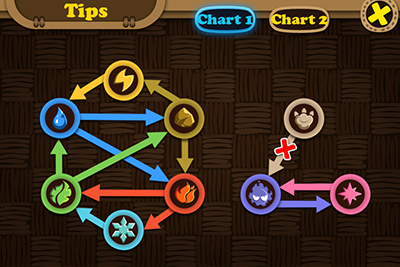
Note: Physical attacks do not work on ghost type monsters because ghosts do not have a solid form.
Monster Type (Physical)
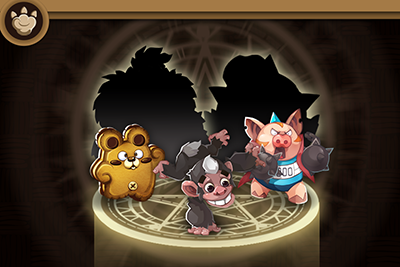
 Physical monsters may not look very threatening, but you can’t judge a book by its cover.
Physical monsters may not look very threatening, but you can’t judge a book by its cover.
Best against: None
Worst against: None
Monster Type (Electric)
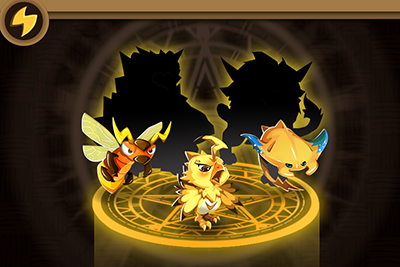
 The bodies glow gold and they are very hot-tempered. They are good at paralyzing their opponents. The crackling sound around them tells you not to get close.
The bodies glow gold and they are very hot-tempered. They are good at paralyzing their opponents. The crackling sound around them tells you not to get close.
Best against: 
Worst against: 
Monster Type (Earth)
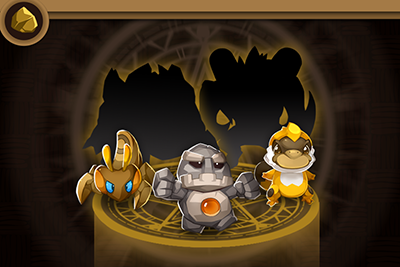
 The strength of the earth renders them fearless and domineering. Stunning opponents with stones is their specialty.
The strength of the earth renders them fearless and domineering. Stunning opponents with stones is their specialty.
Best against:

Worst against: 

Monster Type (Fire)
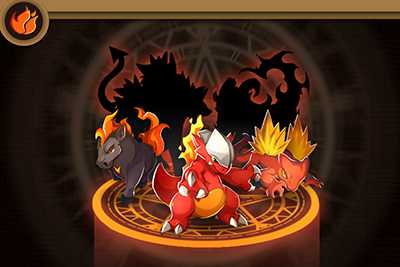
 Their heat burns the air around them. They are so hot you can feel them from several yards away. Don’t get too close.
Their heat burns the air around them. They are so hot you can feel them from several yards away. Don’t get too close.
Best against: 
Worst against:

Monster type (Plant)
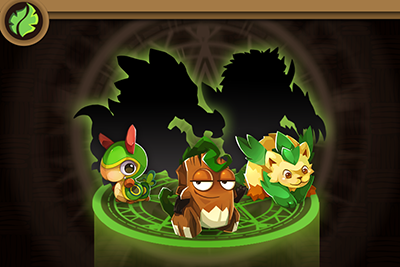
 They hide in grass, bushes and trees, capturing their victims with poisons. If you aren’t careful, you will be engulfed by Mother Nature.
They hide in grass, bushes and trees, capturing their victims with poisons. If you aren’t careful, you will be engulfed by Mother Nature.
Best against: 

Worst against:
Monster type (Water)
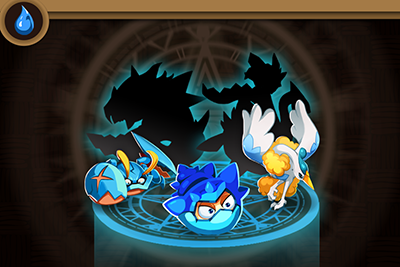
 Water can be both gentle and strong, and so can they. They can use the powers of water to heal themselves.
Water can be both gentle and strong, and so can they. They can use the powers of water to heal themselves.
Best against: 

Worst against: 

Monster type (Magic)
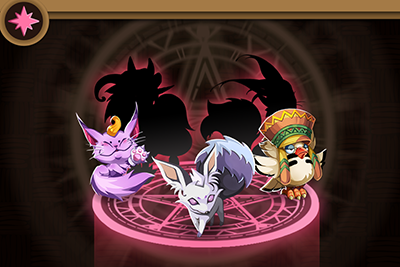
 No one knows where they come from, but nobody dares ask after seeing how powerful they are.
No one knows where they come from, but nobody dares ask after seeing how powerful they are.
Best against: 
Worst against: 
Monster type (Ghost)
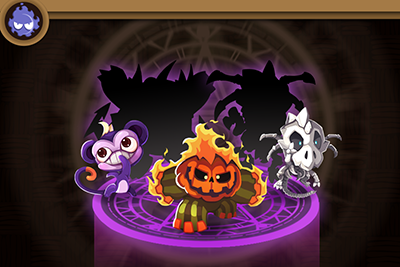
 These haunting monsters are good at tricking their opponents into defeat.
These haunting monsters are good at tricking their opponents into defeat.
Best against:
Worst against:
Monster type (Ice)
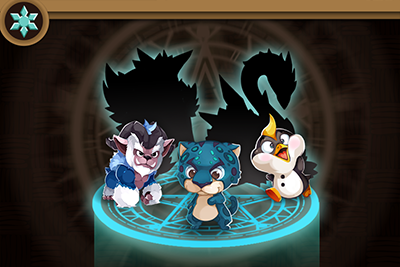
These monsters can survive extreme temperature. They are excellent at slowing down or freezing their opponents.
Best against:
Worst against:
How can I collect more monsters?
You can get a monster through sealing, synthesis, taming, egg-cracking, and tasks.
Seal
You can capture a monster by sealing it within a Seal Card. The rarer a monster is, the lower your success rate for the seal. You can weaken a monster by lowering its health before you seal it.
Synthesis
You can use a scroll to synthesize two or more monsters into a new monster. After the synthesis, you lose the original monsters. There is a chance your new monster will have higher stats than the originals.
You can find scrolls on Team Mode or Veteran Mode.
Requirements for Synthesis:
![]() Scrolls
Scrolls
![]() Monsters listed on the scrolls
Monsters listed on the scrolls
Taming
As you climb up the tower, more and rarer monsters will become available for taming. Strengthen the bond with the monster to obtain it. Once the bond is maxed, the monster will become obtainable.
Requirements for Taming
![]() Plenty of Master Points
Plenty of Master Points
![]() Plenty of daily bond raises.
Plenty of daily bond raises.
![]() For powerful monsters: High position on the Lost Tower.
For powerful monsters: High position on the Lost Tower.
Training
You can level your monsters quickly by training them at the Training center on the Home page. There are four training spots in total, though only one will be available to you when you start the game. The other three can be unlocked when you meet their requirements.
There are three different training levels. Each of the three levels has its own cost, EXP gain and cooldown. Your monster will gain EXP right after the training and the training spot will receive a cooldown.
Higher level players get more EXP from training.
Monsters List
Under the Monsters List, you can view your monsters’ stats, switch equipment, and change their combat order.
Combat Order
You can drag and drop a monster’s portrait to change its position in the combat order.
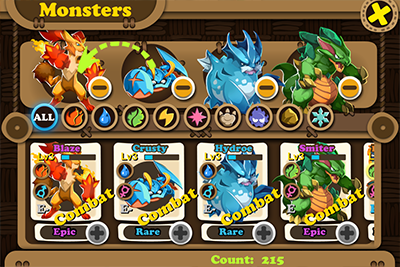
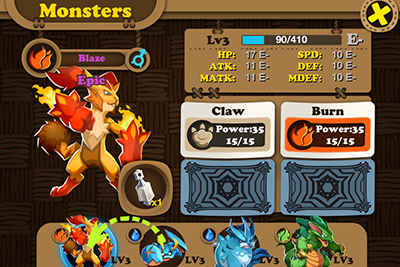
Equipment
You can equip monsters with various rejuvenation aids or weaponry.
Rejuvenation aids can help you recover health (HP) during fights. Example: a combat jelly will activate automatically when your monster is low on health.
Weapons can increase the amount of EXP you gain from fights or boost a specific stat.
Skills
Skills can do damage to your opponents, boost your own stats, or give your opponent a debuff.
Each monster can have up to four skills. Check out each skill’s power, hit rating, power points, and element type.
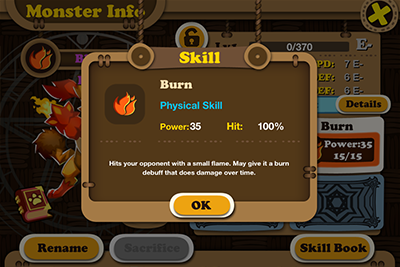
| 1. Skill name. | |
| 2. Power: | Power determines how powerful your skill is. The higher the power is, the more damage/healing the spell does. |
| 3. Hit Rating: | Your hit rating represents the base chance of your monster’s attack landing on its opponent. |
| 4. PP: | PP stands for power points. Power points represent the number of times you can use a certain skill. When you begin a challenge, all of your monster’s skills are at full PP. Skills at 0 PP can no longer be used. PP is automatically restored after every battle. |
| 5. Element: | Each skill has its own element, and each monster has its own element type. If a monster’s element type matches the skill’s element, then the skill becomes 50% more effective. Ex: Draco (fire type) and Poe (physical type) both have the skill Strike, which is a physical attack. Poe will do 50% more damage than Draco when using the same ability. |
| 6. Category: | Skill category. See next section. |
Skill Category
Skills are classified into 3 categories.
![]() Physical Skill: Does damage to your opponent according to your physical attack stats and your opponent’s physical defense stats.
Physical Skill: Does damage to your opponent according to your physical attack stats and your opponent’s physical defense stats.
![]() Magical Skill: Does damage to your opponent according to your magical attack stats and your opponent’s magical defense stats.
Magical Skill: Does damage to your opponent according to your magical attack stats and your opponent’s magical defense stats.
![]() Supplementary Skill: Other skills. Supplementary skills can improve your stats or give your opponent a debuff.
Supplementary Skill: Other skills. Supplementary skills can improve your stats or give your opponent a debuff.
Skill Learning
Each monster can have up to 4 skills through leveling and skill books. You can replace a skill as many times as you want. The only way to replace a skill is by using skill books. You can do this by selecting a book on your monster’s page and selecting which skill you want to replace.
Each monster can learn its own unique set of skills. It is recommended that you learn skills that work best with your monster’s element type.
Stat Grades:
Monsters of the same species can have different stats, even when they are the same level. Stat grades measure a monster’s quality in comparison to fellow monsters. The higher your monster’s grade, the more its stats will increase when leveling.
From high to low, monster grades come in: S, A, B, C, D, E. All grade letters come with + and -, except for the letter S. There are 16 grades in total.
How do I enhance my monster’s grade?
A monster’s grade can be enhanced by absorbing other monsters. Two monsters of the same species, level, and grade will have the same stats. You can access the Enhance feature at the Enhance Tree once you reach level 15.
Absorb:
All monsters can be absorbed. The boosts given to each stat are determined by the monsters absorbed. A monster, when absorbed, can give different boosts to different monsters. Powerful monsters will give you greater stat boosts, but they are hidden further in the game.
Monster Evolution
Monsters will evolve after meeting certain requirements. Evolved monsters have a different look and stronger stats. They can also learn new skills.
To evolve, monsters need to meet the following requirements:
![]() They need to meet the level requirement.
They need to meet the level requirement.
![]() If a monster needs a catalyst to evolve, you need to equip the catalyst and then meet the level requirements for the evolution.
If a monster needs a catalyst to evolve, you need to equip the catalyst and then meet the level requirements for the evolution.
Monster Encyclopedia
The Monster Encyclopedia gives you a look at the details of all monsters you have unveiled. This includes their Encyclopedia number, name, image, rarity, evolution requirements, and more. Some of the details are only available after you capture the monster. You can purchase the unveiled monsters in your Encyclopedia with coins.
Open Monster Encyclopedia